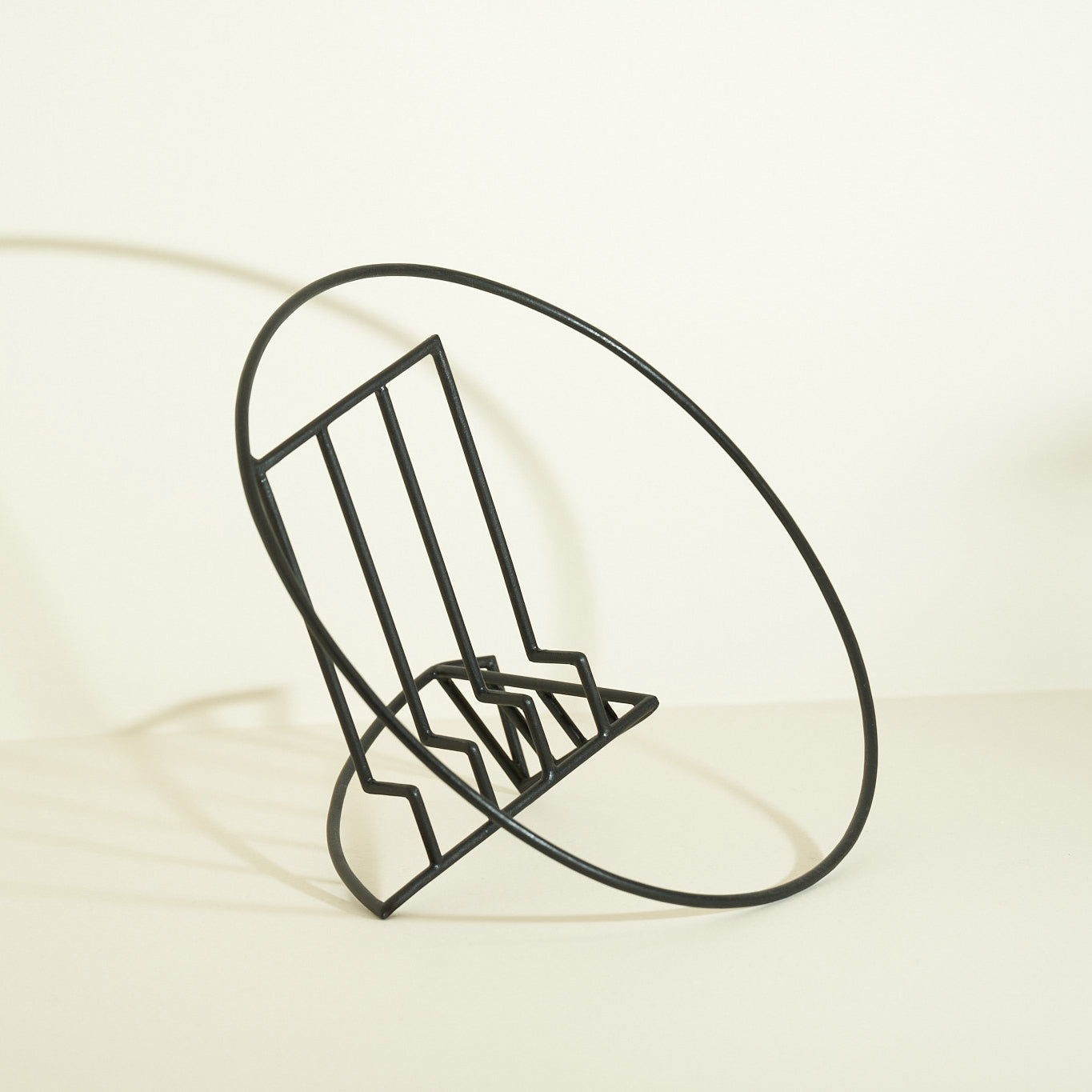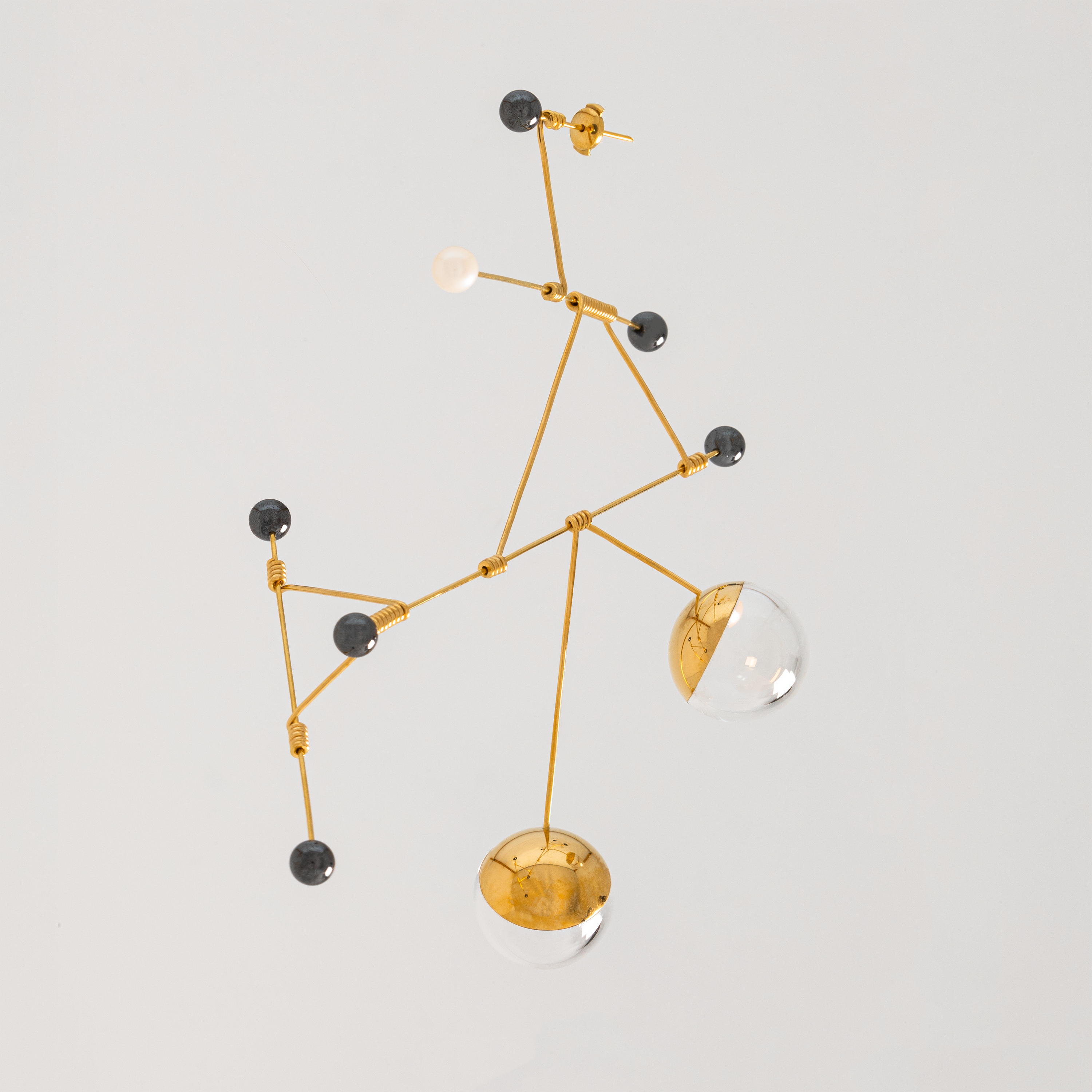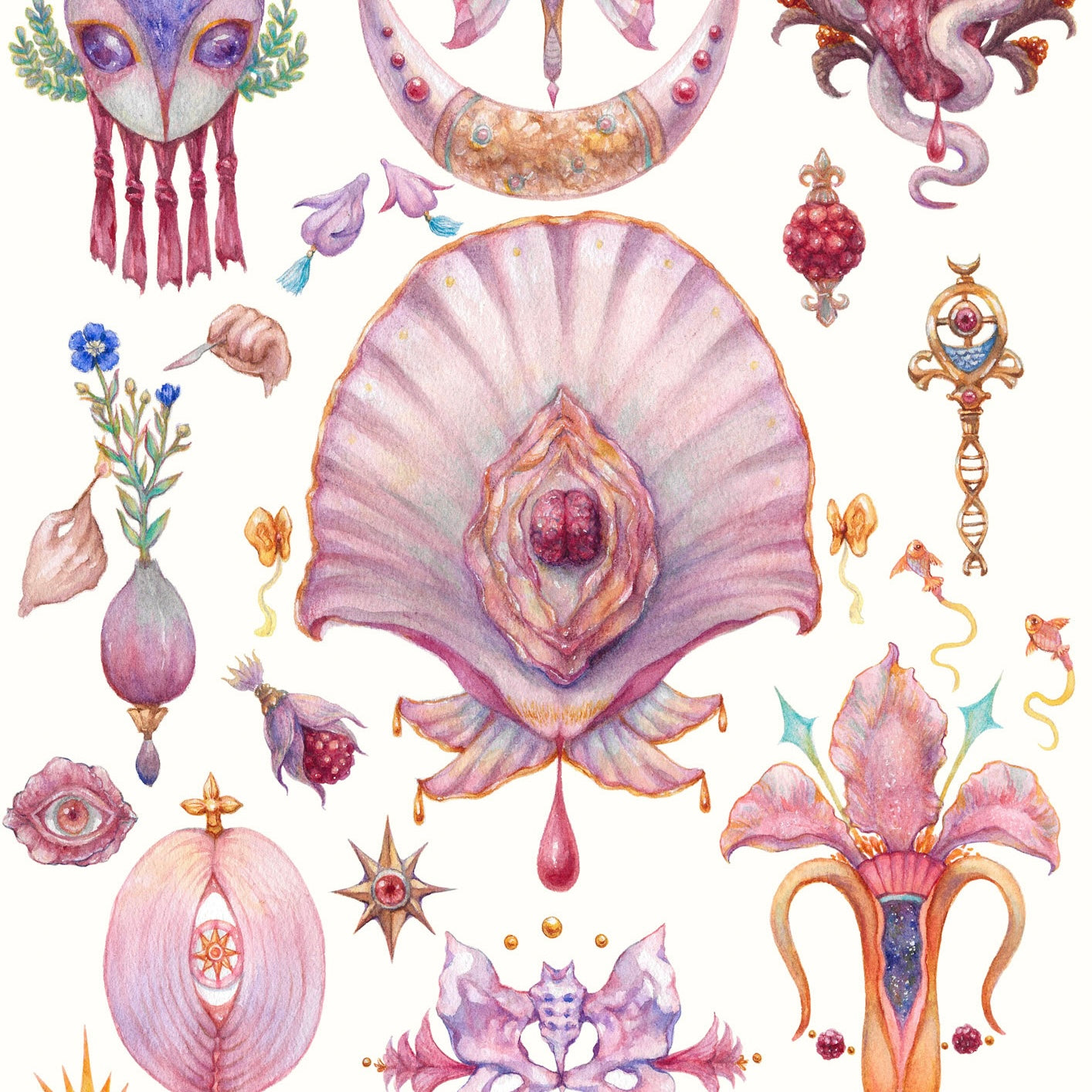A Journey from Jewellery to Monumental Metalwork with Jacky Oliver
What inspired your transition from crafting jewellery to embracing larger-scale metalwork, and how has your jewellery background influenced this shift, especially in architectural creations?
When I did a jewelry degree at Middlesex, which was really experimental, and she worked with lots of different materials. But when I did my foundation course, the course before my degree, I didn't like metal. But the first day I was at Middlesex and we got taught how to use a piercing saw and solder, I absolutely loved it, I love the control that allows. But while I was working, while I was doing my degree, I also worked in a jewelry shop on Saturdays. And people would come into the jewelry shop and they would forget that they were wearing some earrings, but someone had spent hours and hours making. I also worked for lots of different jewelers, and I couldn't think of anything that was going to be better than what everyone else was making already.
So I decided to the bits that I did when I was at the Royal College, were pieces that made the wearer feel particular stretches. I was really interested in the anatomy of the body. So it became more sculptural pieces, but you could only wear the piece when you were holding a particular stretch. I wanted the wearer to be conscious of the pieces that I made. I don't want them to be able to be ignored.
And then as soon as I left Royal College, I did a blacksmithing course and that allowed me. My tutor had suggested that I looked at tapering the metal, but I didn't quite understand what he meant. I really wish that I didn’t do the blacksmithing course, before I went and did my MA. It was just completely transformative seeing how metal changes cross section, and that encouraged me to work larger and larger. But I've always had the same attention to detail when I was making some 14-foot archways for a school. I was still cleaning them up with a needle file. The people in the forge where I was working, they were going: what are you doing? And I was saying: well, people will always remember you for your worst part of your work, they'll notice that.
I love the attention to detail that studying in jewelry has led me to, and I think that I can explore ideas really well on a small scale. And then they could be translated to a larger scale. But I quite like now, I’m very happy working on a more domestic sorts of scale rather than a huge architectural scale.
Could you describe your approach to design, particularly how you integrate your diverse interests and research into your creations?
I have a different sort of process, but it all feeds into each other.
For a lot of my commissions, it's based on going through archives, finding different looking at different subject matter. So I’ve looked at projects from commemorating the 100th anniversary of Armistice Day, to the history of a horse in agriculture, to a cinema in north London, or working with scientists in Exeter University. And what I love is discovering new things. So I’ll go to an archival with the scientists, they gave me loads of documents and diagrams, and explained how this particular parasite worked. Then I'll do lots of model making.
One of the things that I really like is having personal connections with the work that I make. For the project for Exeter University, I asked the scientists, if they could write down the names of the parasites, and what they ended up doing was giving me a couple of pages of their lab notes, which was amazing.
I etched vows onto the metal. And the first time I used handwriting was when I spoke to a veteran from the second world war, he gave me a document with his handwriting on the back. I really love different generations of handwriting. And for Armistice Day, I did a piece that was celebrating the end of the first world war. I got people from all different nationalities to get their oldest relative to write the word peace. Handwriting is really important in the commissions where it's kind of historical or where its information based. But then I will etch, and I will enamel, and I’ll use those documents. But then I’ll always make a wire framework, and that will be taken from lots and lots of drawing from objects, and then I simplify it down.
When I’m doing work for commercial galleries, I normally take ideas, but I haven't fully explored to do with the form of earlier projects I developed those. And I like working in series, so I’ll make a piece, and then I’ll turn it round, and look at it from different angles, and work out what I like, and then make another version of it, trying to explore that. It involves a lot of drawing, a lot of making, a lot of turning around. And what I love about the materials I work in, which is steel and silver solded. It is I can make a piece, and then I can unsold a bit, take a bit off, chop it, change it, and it allows for peace to really transform throughout the making process.

From where do you draw your inspiration, especially considering your varied projects and the role of historical and local research in your work?
I get inspiration from all the different projects I have. At the moment, I’m working on an Artist in Residence, in Bunhill, which is an area near Old Street, south of Islington. I'm going through archives, I’m speaking to people, so it's looking at the history of the area. And I’m looking at type foundries, I’m looking at the castle on typeface. I'm looking at playing cards because there was a print works that changed how playing cards were made. And talking to people is really important finding out what they're interested in.
I'm really lucky that I’ve had lots of different projects, and each project I do, I get far more research than I need. I got a project that I did in 2017, and I’ve still got some maps from that, but I’m desperate to use, but I just need to find the time to make that. So normally it's really good. I don't think yet I’ve run out of inspiration, but it is from a huge range of ideas, of sources, of inspiration.
With your expertise in a wide array of metalwork techniques, which ones do you favor the most, and how do they enrich your artistic expression?
That's quite difficult because I love them all. But the one that I use most in my work is soldering. For most of my work. It's really simple because it's linear, steel work that silver soldered. I still, after 30 years, just love when you watch for the bead of so silver just flowing. That's quite good because I do that quite often quite a lot many times in a day.
But I also really love the sort of like collaging, when I’m etching or enameling, where I’m layering up different information or different designs, different artifacts, different text, or textures. I really like that because I have no control over that, or I feel like I have no control. So I’ll etch some text, and then I’ll edge something over it and where it overlaps. I'm out of control of how those two marks interact.
I like the fact that with the lines in my work, I have sort of complete control, but also, as I’m putting elements together. So I’ll make a shape out of wire, and then I’ll solder another element on it. I'm really indecisive, the most indecisive person I’ve ever met.
So every time I’m solding a piece together, I’m thinking, is that right? And quite often I’ll take it out and change it, or I make another version of what I’ve just made, but have it slightly differently. It's I love the fact that I can do that.
I did a collaboration with a glass blower. With what we did there, I made some metal, and he blew his glass on it, and you get one chance to do it, and you put it in the kiln. With me, I’ve got the piece if I don't like it, I can chop it up, I can add something to it, I can take a bit away, and I quite often do that as well.
I love the versatile nature of working with metal. I do love forging, tapering out and changing the cross section of metal. But I've done years of that, and I’ve got really bad back. Now I mainly keep the metal all the same width, I don't hammer it. But that is something that I absolutely loved previously.

In curating your exhibition, we noticed varied light and shadow effects based on the angle of display. Do you intentionally design each piece with a specific orientation in mind, or do these effects emerge spontaneously?
No. Most of the pieces start off with an idea in mind. Then normally all the pieces that I work that you exhibited came from, they were had initial drawing. And a lot of pieces came from a series where I just made 1 piece for what if I change just one small element, then I think I made a series of about 15 pieces for the compositions. And as I’m making them, quite often, when I finish a piece, I’ll photograph it and think: oh, actually it's better from this angle or it's better from that angle. And then I might add a bit so that it holds or sits in a different way.
But what I really love my earlier work, when I did my MA. It was these large pieces that sat on my body, and it had to be placed in one particular direction. I would find that I’d take them to for an exhibition and people would put them upside down, and I think: oh no, you can't see, but that's for a particular muscle.
Now I’m much more playful with my work, and I’ve got a rack in my in my workshop where I hang all my pieces from when I’m making them, so that they're not on the workbench. And then I’ll hang them in different positions, that's what I love about working three dimensionally, but they do work so differently from different angles, that's a purposeful thing. So I love to see how other people position, because quite often I would have never thought of I have an idea how I’m making it. And then someone else puts it in a completely different position. I'm like that looks much better than the way I imagined it.
But the shadows are really important, and sometimes I’ll photograph a piece, and then think that's too complex, or actually I need to add a bit to it. For me, it's really important, I really like the way that the pieces cast shadows.
How have recognitions such as the Crafts Council selection and Arts Council grants influenced your career and opened up new opportunities for your work?
Being selected for Collect by the crafts council was amazing, I didn't expect when I applied. They said sometimes it takes 2 or 3 times to get it. So when I got it first time, I was a little bit shocked, but it was fantastic. And having the Arts Council funding, it allowed me to do the work and not have the pressure to sell it. I could make exactly what I wanted, which was really good. And it also enabled me to do workshops to different people and talk about my work and get feedback from it, which is always an important part of my work.
And also, getting the Arts Council grant, being selected by the Crafts Council, having the Bursary that I’ve got a Cockpit, it all sometimes, when you're making a way in a workshop all by yourself, you wonder why you're doing it or whether you should be doing it and having a that sort of recognition, help you think that your work is going in the right direction.

What significance does the inclusion of your sculptures in museum collections hold for you and your artistic legacy?
Oh, It's brilliant, It's such a privilege. I've had pieces that are in handling collections or in Poole Museum, in Teignmouth... So sometimes having a piece in a collection means that they've got the piece and they can bring it out, but they don't have it all always on display. But in Teignmouth, it's lovely, they've got my piece suspended as you go up the stairs. Different people see it and let me know that they've seen it. And I really enjoy making pieces for people's homes, but I think public sculptures that are shown in museums is a fantastic seal of approval. Really nice to know that different people can see how I’ve interpreted things from the collection.
Also the idea of a lot of a time, the projects I do are to help promote the collection in the museum, so that it hopefully draws more people to see, and think about the particular objects I've been inspired by, that's exactly my absolute dream commission.
Could you share some of the challenges you've faced in your creative process, especially when working on large-scale public commissions?
I think the hardest thing has been when I’ve been commissioned for large scale public commissions. And there you'll end up submitting a few designs. And then, the designs have to get refined because of problems with planning and permission, or health and safety, or to meet the approval of a committee. So the designs end up not being quite as exciting or as they were in the beginning, I think I found that harder. I think working on a smaller scale has allowed me to have more freedom in my work.
How has your role as the Bunhill Artist in Residence in Islington contributed to your development as an artist and your interaction with the community?
This is the first time, really, I’ve worked in London on this sort of scale, which is amazing. I’ve been working for 30 years. I've been to Aberdeen, I’ve been to Devon, I go all around the country. Today, I could get the bus to my residency studio here, it's been brilliant. The archives that I can go to as many times as possible. And I'm doing it's a yearlong residency and I haven't had a residency that long. So I'm able to go into much more depth and meet more people and discuss ideas.
My ideas have developed quite a lot in the last 6 months, but I'm sure that in the next 6 months we're gonna change and develop. I've been able to meet the community groups, I'm working with men in shed, like more mature men. I’ve been working with families, women, groups, and I’ve been sharing my creative process and also encouraging these people to try out different: we've been doing cut and fish casting, and we've been doing we cast in plaster, and we've worked with wire and different materials. It's really nice to share the creative process, but also to do something that is gonna have some significance to the local people, the final outcome.
What advice would you offer to someone embarking on a career in jewellery or metalwork?
Do what you love doing, because then you'll do more of it. And the more you do of it, the better you'll get.
I think that in the last 2 years ago, I started it at Cockpit Arts and we have business coaching there. And that completely changed things, it helped me push my work a lot, be more proactive.
I think one of the things that I’ve always done is before the internet, I was sending out slides of my work to lots of galleries and not to be frightened, to make an effort to push your work and show people your work. But do make sure it's something that you wanna do because you need to spend a lot of time doing it, but just make as much effort.
And also, I think, but it's important to make the most of every opportunity to show your work. There's been different times when my dad was organizing a local exhibition, and I was thinking this is gonna not be very important. It ends up someone bought a piece and then someone else wanted the same piece, and then they came round and they ended up committed to commissioning me for a huge method work commission, my biggest one today.
So you never know what an opportunity might lead to, even if you don't think that it's the most prestigious, that was a little show a in a small hall. But it led to some really good work. So just make for most of every everything you can do, every opportunity.





Leave a comment
This site is protected by hCaptcha and the hCaptcha Privacy Policy and Terms of Service apply.